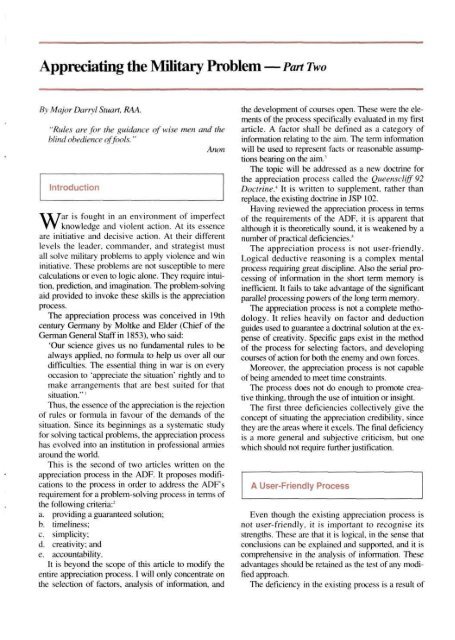ISSUE 107 : Jul/Aug - 1994 - Australian Defence Force Journal
ISSUE 107 : Jul/Aug - 1994 - Australian Defence Force Journal
ISSUE 107 : Jul/Aug - 1994 - Australian Defence Force Journal
You also want an ePaper? Increase the reach of your titles
YUMPU automatically turns print PDFs into web optimized ePapers that Google loves.
Appreciating the Military Problem — Part TwoBy Major Darn I Smart, RAA."Rules are for the guidance of wise men and theblind obedience of fools. "AnonIntroductionWar is fought in an environment of imperfectknowledge and violent action. At its essenceare initiative and decisive action. At their differentlevels the leader, commander, and strategist mustall solve military problems to apply violence and wininitiative. These problems are not susceptible to merecalculations or even to logic alone. They require intuition,prediction, and imagination. The problem-solvingaid provided to invoke these skills is the appreciationprocess.The appreciation process was conceived in 19thcentury Germany by Moltke and Elder (Chief of theGerman General Staff in 1853), who said:'Our science gives us no fundamental rules to bealways applied, no formula to help us over all ourdifficulties. The essential thing in war is on everyoccasion to 'appreciate the situation' rightly and tomake arrangements that are best suited for thatsituation."'Thus, the essence of the appreciation is the rejectionof rules or formula in favour of the demands of thesituation. Since its beginnings as a systematic studyfor solving tactical problems, the appreciation processhas evolved into an institution in professional armiesaround the world.This is the second of two articles written on theappreciation process in the ADF. It proposes modificationsto the process in order to address the ADF'srequirement for a problem-solving process in terms ofthe following criteria: 2a. providing a guaranteed solution;b. timeliness;c. simplicity;d. creativity; ande. accountability.It is beyond the scope of this article to modify theentire appreciation process. I will only concentrate onthe selection of factors, analysis of information, andthe development of courses open. These were the elementsof the process specifically evaluated in my firstarticle. A factor shall be defined as a category ofinformation relating to the aim. The term informationwill be used to represent facts or reasonable assumptionsbearing on the aim.'The topic will be addressed as a new doctrine forthe appreciation process called the Queenscliff 92Doctrine. 1 It is written to supplement, rather thanreplace, the existing doctrine in JSP 102.Having reviewed the appreciation process in termsof the requirements of the ADF, it is apparent thatalthough it is theoretically sound, it is weakened by anumber of practical deficiencies. 5The appreciation process is not user-friendly.Logical deductive reasoning is a complex mentalprocess requiring great discipline. Also the serial processingof information in the short term memory isinefficient. It fails to take advantage of the significantparallel processing powers of the long term memory.The appreciation process is not a complete methodology.It relies heavily on factor and deductionguides used to guarantee a doctrinal solution at the expenseof creativity. Specific gaps exist in the methodof the process for selecting factors, and developingcourses of action for both the enemy and own forces.Moreover, the appreciation process is not capableof being amended to meet time constraints.The process does not do enough to promote creativethinking, through the use of intuition or insight.The first three deficiencies collectively give theconcept of situating the appreciation credibility, sincethey are the areas where it excels. The final deficiencyis a more general and subjective criticism, but onewhich should not require further justification.A User-Friendly ProcessEven though the existing appreciation process isnot user-friendly, it is important to recognise itsstrengths. These are that it is logical, in the sense thatconclusions can be explained and supported, and it iscomprehensive in the analysis of information. Theseadvantages should be retained as the test of any modifiedapproach.The deficiency in the existing process is a result of
















